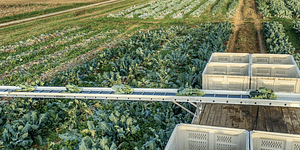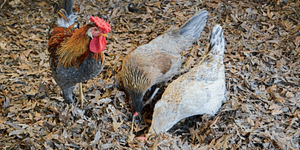Why Rabbit is the New Chicken

Not convinced that a pasture-based rabbit production could amount to a sustainable business enterprise for the beginner to market-scale farmer? Nichki Carangelo, a third-generation Italian American, second-generation small business owner, and first-generation farmer from Waterbury, Connecticut, proves that a viable pasture-based rabbitry is not only user-friendly, it’s also profitable. In 2014, she founded Letterbox Farm Collective in Hudson, New York, which now contributes to a burgeoning local food economy.
The following excerpt from Carangelo’s book, Raising Pastured Rabbits for Meat, makes the case for rabbits over chicken. It has been adapted for the web from the Winter 2020 Seasonal Journal.
In a country with a $41 billion broiler chicken industry, Michael Pollan’s 2010 claim that “rabbits make more sense than chicken” seems pretty bold, but Time magazine agreed in its piece, “How Rabbits Can Save the World.” Even the New York Times has hopped aboard the bandwagon. The wider world is abuzz about the supposed super protein, and yet very few farmers are stepping up to meet the rapidly increasing interest in sustainably raised rabbit.
I can’t help but wonder why, as I see tremendous opportunity for any new and seasoned agrarians willing to learn this increasingly lost art of raising such triple-purpose wonders. With comparatively little money, space, or labor, rabbits can earn you an honest living and return some much-needed (and demonstrably desirable) diversity back into the markets for food, fiber, and fertility.
For starters, rabbits are easy to handle. 
Unlike a lot of other livestock, they’re small and docile. Well-bred rabbits from good stock are unaggressive and easy to pick up and move around. Plus, they aren’t heavy. Even the largest breed of domestic rabbit, the Flemish Giant, maxes out at a very manageable 22 pounds (10 kg).
Rabbits, and everything they require, are light and portable. This is true in terms of both daily chores and major moves, like relocating to a new piece of land. Aside from mobile rabbit tractors, of which you’ll need some version, should you decide to use a pasture-based method, the heaviest item on the list is going to be a wheelbarrow. . . .
That rabbits are so portable makes them a great starter enterprise or farmers and homesteaders without secure land tenure. Unlike some larger livestock, like dairy cows, who require more permanent infrastructure like a milking parlor, or goats who may need extensive fencing systems, everything you need for a rabbitry can fit right into a U-Haul and be moved across town or even cross-country in a jiff.
Rabbits require minimal start-up capital. In fact, a well-managed commercial rabbitry can repay its entire initial investment in a single year.
Finally, rabbit adds diversity to your diet. The traditional American dinner plate had a lot more than beef, chicken, and pork on it. Prior to the widespread implementation of concentrated animal feeding operations (CAFOs), which heavily focused on the production of these three proteins, our dinner tables were laden with a wide variety of proteins, like venison, bison, pheasant, and of course rabbit. To eat rabbit is to eat food that is rich in heritage.
Recommended Reads
Recent Articles
Oxeye daisies are one of the most important plants for pollinators including beetles, ants, and moths that use oxeye daisies as a source of pollen and nectar. Instead of thinking about removing a plant like oxeye daisy, consider how you can improve the fertility and diversity of habitat resources in your home landscape, garden, or…
Read MoreSo you want to start reaping your harvest, but you’re not sure where to start? Learn how to break down the options of harvesting tools!
Read MoreWhat’s so great about oyster mushrooms? First, you can add them to the list of foods that can be grown indoors! They are tasty, easy to grow, multiply fast, and they love a variety of substrates, making oyster mushrooms the premium choice. The following is an excerpt from Fresh Food from Small Spaces by R. J.…
Read MoreEver heard the phrase, “always follow your nose?” As it turns out, this is a good rule of thumb when it comes to chicken manure. Composting chicken manure in deep litter helps build better chicken health, reduce labor, and retain most of the nutrients for your garden. The following is an excerpt from The Small-Scale Poultry…
Read More









